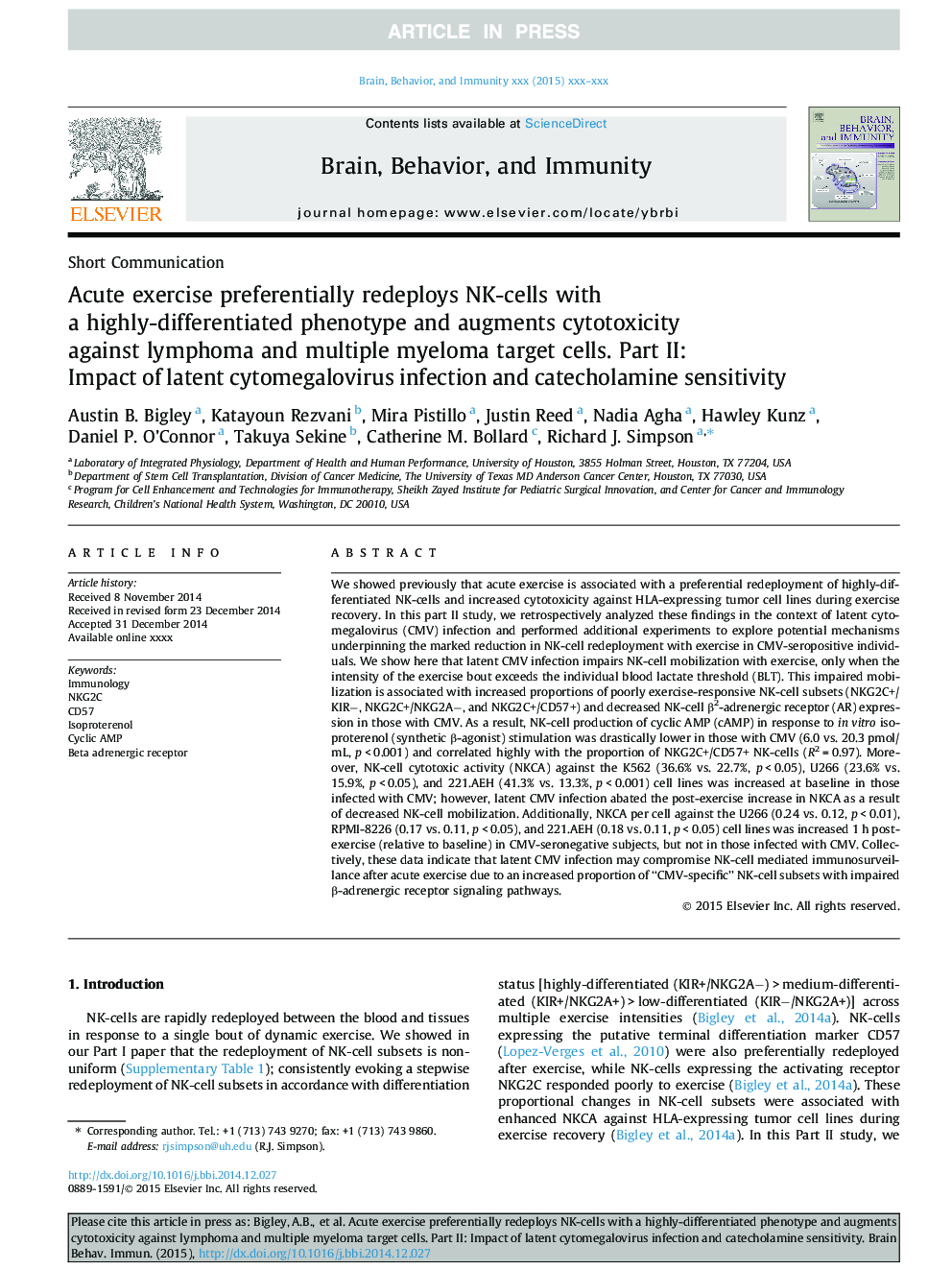| کد مقاله | کد نشریه | سال انتشار | مقاله انگلیسی | نسخه تمام متن |
|---|---|---|---|---|
| 7280731 | 1473918 | 2015 | 7 صفحه PDF | دانلود رایگان |
عنوان انگلیسی مقاله ISI
Acute exercise preferentially redeploys NK-cells with a highly-differentiated phenotype and augments cytotoxicity against lymphoma and multiple myeloma target cells. Part II: Impact of latent cytomegalovirus infection and catecholamine sensitivity
دانلود مقاله + سفارش ترجمه
دانلود مقاله ISI انگلیسی
رایگان برای ایرانیان
کلمات کلیدی
موضوعات مرتبط
علوم زیستی و بیوفناوری
ایمنی شناسی و میکروب شناسی
ایمونولوژی
پیش نمایش صفحه اول مقاله

چکیده انگلیسی
We showed previously that acute exercise is associated with a preferential redeployment of highly-differentiated NK-cells and increased cytotoxicity against HLA-expressing tumor cell lines during exercise recovery. In this part II study, we retrospectively analyzed these findings in the context of latent cytomegalovirus (CMV) infection and performed additional experiments to explore potential mechanisms underpinning the marked reduction in NK-cell redeployment with exercise in CMV-seropositive individuals. We show here that latent CMV infection impairs NK-cell mobilization with exercise, only when the intensity of the exercise bout exceeds the individual blood lactate threshold (BLT). This impaired mobilization is associated with increased proportions of poorly exercise-responsive NK-cell subsets (NKG2C+/KIRâ, NKG2C+/NKG2Aâ, and NKG2C+/CD57+) and decreased NK-cell β2-adrenergic receptor (AR) expression in those with CMV. As a result, NK-cell production of cyclic AMP (cAMP) in response to in vitro isoproterenol (synthetic β-agonist) stimulation was drastically lower in those with CMV (6.0 vs. 20.3 pmol/mL, p < 0.001) and correlated highly with the proportion of NKG2C+/CD57+ NK-cells (R2 = 0.97). Moreover, NK-cell cytotoxic activity (NKCA) against the K562 (36.6% vs. 22.7%, p < 0.05), U266 (23.6% vs. 15.9%, p < 0.05), and 221.AEH (41.3% vs. 13.3%, p < 0.001) cell lines was increased at baseline in those infected with CMV; however, latent CMV infection abated the post-exercise increase in NKCA as a result of decreased NK-cell mobilization. Additionally, NKCA per cell against the U266 (0.24 vs. 0.12, p < 0.01), RPMI-8226 (0.17 vs. 0.11, p < 0.05), and 221.AEH (0.18 vs. 0.11, p < 0.05) cell lines was increased 1 h post-exercise (relative to baseline) in CMV-seronegative subjects, but not in those infected with CMV. Collectively, these data indicate that latent CMV infection may compromise NK-cell mediated immunosurveillance after acute exercise due to an increased proportion of “CMV-specific” NK-cell subsets with impaired β-adrenergic receptor signaling pathways.
ناشر
Database: Elsevier - ScienceDirect (ساینس دایرکت)
Journal: Brain, Behavior, and Immunity - Volume 49, October 2015, Pages 59-65
Journal: Brain, Behavior, and Immunity - Volume 49, October 2015, Pages 59-65
نویسندگان
Austin B. Bigley, Katayoun Rezvani, Mira Pistillo, Justin Reed, Nadia Agha, Hawley Kunz, Daniel P. O'Connor, Takuya Sekine, Catherine M. Bollard, Richard J. Simpson,